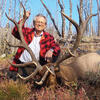
B&C Member Spotlight — Valerius Geist
When Valerius Geist walked into a room, it didn’t take long before everyone gravitated toward him. Regardless of the topic, his infectious enthusiasm drew colleagues and students into conversations th...
Boone and Crockett Club members have come from a cross-section of famous accomplished people whose lives and careers have written and recorded the history of this country since the late 19th Century. They have been naturalists, scientists, explorers and sportsmen, writers and academicians, artists, statesmen and politicians, generals, bankers, financiers, philanthropists, and industrialists. Their diversity of ideas and activities during their careers have made the Boone and Crockett Club rich in its fellowship and achievements. Below you'll find spotlights of early B&C members. This is a work in progress and additional spotlights will continue to be featured.